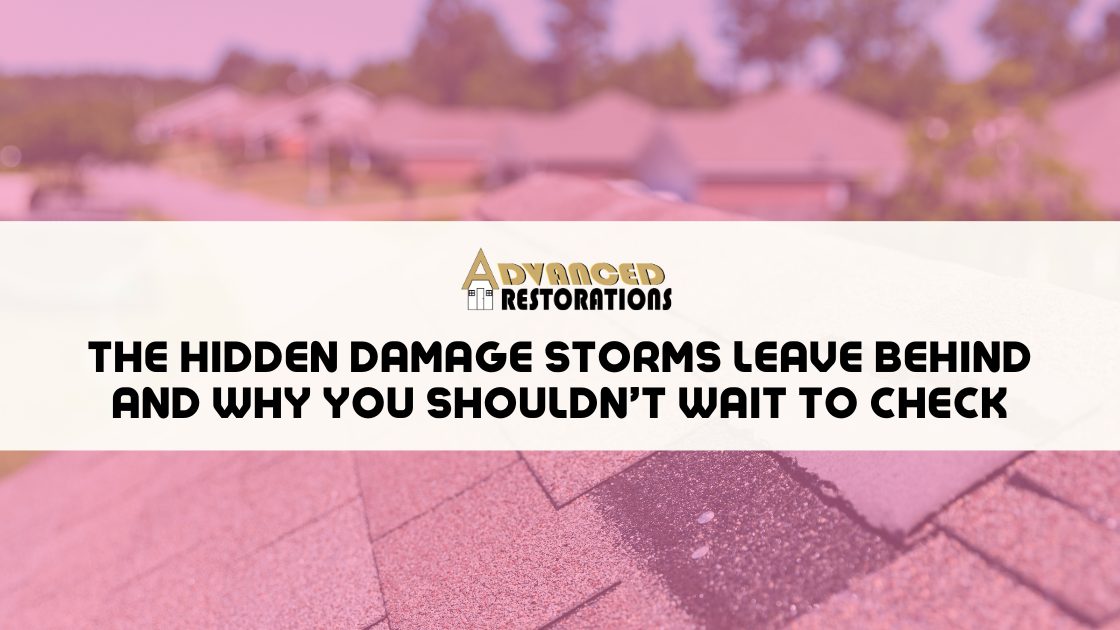
The Hidden Damage Storms Leave Behind-And Why You Shouldn’t Wait to Check
What You Can’t See Could Cost You
In the Ozarks, storms are a fact of life, especially in spring and early summer. But after the thunder fades and the skies clear, many homeowners assume their home made it through unscathed. Unfortunately, that’s not always the case.
Hail and high winds can cause damage that isn’t immediately obvious. It may take weeks, or even months, for the signs to appear. And by the time they do, you could be facing far more expensive repairs than if the issue had been caught early.
At Advanced Restorations, we’ve seen it time and time again. Homeowners delay inspections because everything “looks fine,” only to discover hidden roof leaks, sagging gutters, or interior damage down the road.
What Kinds of Storm Damage Are Hard to Spot?
While major issues like missing shingles are easy to see from the ground, subtle storm damage often goes unnoticed without a professional inspection. Here are some of the most common types of hidden damage:
- Bruised or fractured shingles: Hail can cause impact points that weaken the protective surface of shingles. These don’t always show visible dents but can lead to leaks over time.
- Granule loss: The protective granules on shingles can be loosened by hail or wind. These often wash into your gutters or downspouts and leave shingles more vulnerable to UV damage and water intrusion.
- Lifted or creased shingles: Wind can loosen shingles without fully detaching them. This breaks the seal and leaves areas exposed to water during the next storm.
- Gutter damage: High winds or heavy hail can bend or dislodge gutter sections, even if they appear intact from a distance. Damaged gutters can’t properly direct water away from your foundation, leading to drainage problems and erosion.
Why Waiting Makes Things Worse
The longer you wait to inspect your roof and gutters after a storm, the higher your risk of:
- Leaks spreading into your attic or walls
- Mold and moisture issues inside your home
- Rotting roof decking or framing
- Structural damage
- Insurance claim denial due to delayed reporting
Storm damage is easier and less expensive to repair when caught early. Once it starts impacting other parts of your home, repair costs, and the inconvenience go up fast.
How to Know If a Storm Hit Your Home
Even if you didn’t experience obvious damage or recall a major storm, it’s worth checking your home’s storm history. That’s where our Extreme Weather Report comes in.
This free tool uses verified radar and storm tracking data to identify:
- Hail and wind events at your exact address
- Storm dates within the past two years (which may qualify for insurance coverage)
- Weather intensity and conditions during those events
If your home shows up on the report, it’s worth scheduling an inspection even if everything still “looks okay.”
Click here to download your free Extreme Weather Report.
What to Do Next
If your storm report shows qualifying events, or if you’ve noticed signs like shingle granules in your gutters, don’t wait. Contact Advanced Restorations to schedule a free inspection with one of our Field Supervisors.
Our trained team will:
- Check your roofing system for hidden damage
- Evaluate gutters, flashing, vents, and drainage
- Provide documentation and support if you choose to file an insurance claim
Stay Ahead of the Storm
Storm damage isn’t always loud, messy, or immediate. Sometimes, it’s quiet and slow—but just as serious. The good news is, with the right tools and a quick inspection, you can catch problems before they spiral into major issues.
Start with your Extreme Weather Report, and let Advanced Restorations handle the rest.
